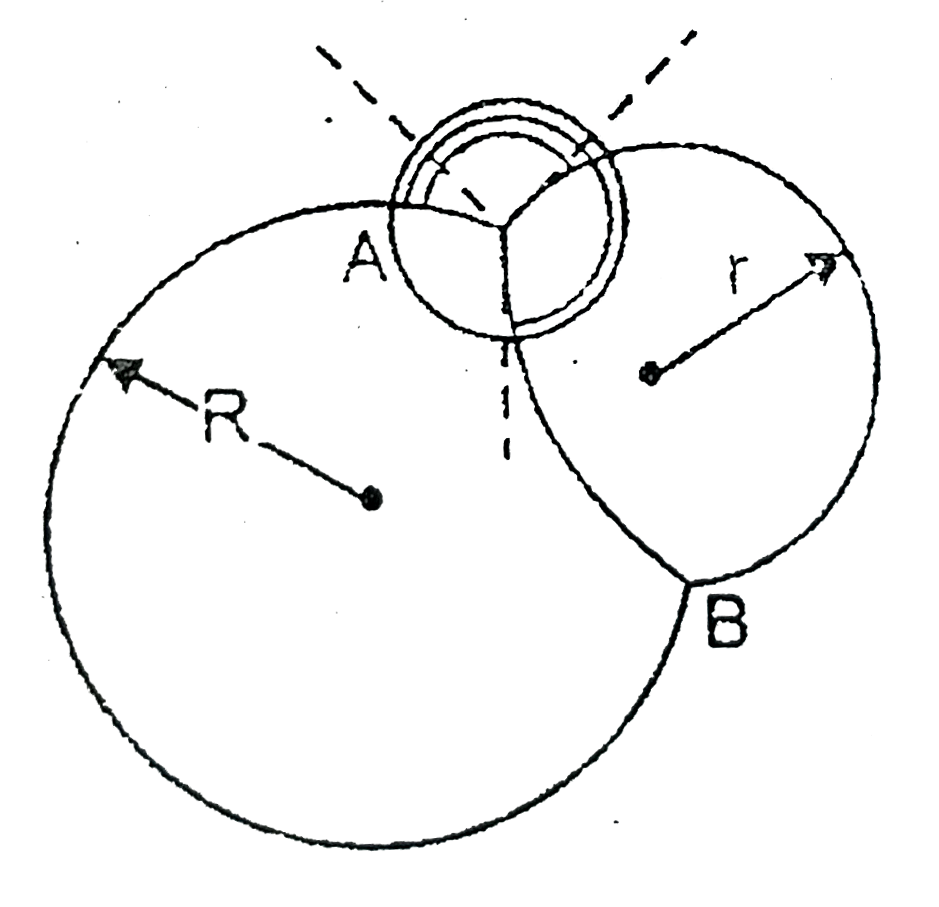Two soap bubbles with radius 2r and 3r come in contact. Their common surface has a radius of curvature nr, then find the value of n
To find the value of n for the common surface of two soap bubbles with radii 2r and 3r, we can follow these steps:
Step 1: Understand the relationship between pressure difference and radius of curvature
The pressure difference between two soap bubbles is given by the formula:
ΔP=4TR
where T is the surface tension and R is the radius of curvature.
Step 2: Set up the equation for the two bubbles
Let:
- R1=3r (radius of the larger bubble)
- R2=2r (radius of the smaller bubble)
The pressure difference between the two bubbles can be expressed as:
ΔP=4TR2−4TR1
Step 3: Substitute the values of R1 and R2
Substituting R1 and R2 into the equation gives:
ΔP=4T2r−4T3r
Step 4: Simplify the pressure difference equation
Calculating the right-hand side:
ΔP=4T2r−4T3r=6T3r−4T3r=2T3r
Step 5: Relate the pressure difference to the radius of curvature of the common surface
For the common surface with radius of curvature nR, we have:
ΔP=4TnR
Step 6: Set the two expressions for pressure difference equal to each other
Equating the two expressions for ΔP:
4TnR=2T3r
Step 7: Cancel T and rearrange the equation
Cancelling T from both sides gives:
4n=23
Step 8: Solve for n
Cross-multiplying to solve for n:
4⋅3=2n⟹12=2n⟹n=6
Final Answer
Thus, the value of n is:
6
The pressure difference between two soap bubbles is given by the formula:
ΔP=4TR
where T is the surface tension and R is the radius of curvature.
Let:
- R1=3r (radius of the larger bubble)
- R2=2r (radius of the smaller bubble)
ΔP=4TR2−4TR1
Substituting R1 and R2 into the equation gives:
ΔP=4T2r−4T3r
Calculating the right-hand side:
ΔP=4T2r−4T3r=6T3r−4T3r=2T3r
For the common surface with radius of curvature nR, we have:
ΔP=4TnR
Equating the two expressions for ΔP:
4TnR=2T3r
Cancelling T from both sides gives:
4n=23
Cross-multiplying to solve for n:
4⋅3=2n⟹12=2n⟹n=6
Thus, the value of n is:
6
Topper's Solved these Questions
Similar Questions
Two soap bubbles of radii 2 cm and 3 cm are brought in contact. Find the radius of curvature (in cm) of the contact surface.
View SolutionTwo soap bubbles of radii 2 cm and 4 cm join to form a double bubble in air, then radius of. curvature of interface is
View SolutionTwo soap bubbles, one of radius 50mm and the other of radius 80mm, are brought in contact so that they have a common interface. The radius of the curvature of the common interface is
View SolutionA soap bubble A of radius 0.03 m and another bubble B of radius 0.04 m are brought together, so that the combined bubble has a common interface of radius r, then the value of r is
View SolutionTwo soap bubbles are stuck together with an intermediate film separating them. Compute the radius of curvature of this film given that the radii of the bubbles in this arrangement are r1 and r2 respectively. If r1>r2 state clearly which way the intermediate film will bulge.
For the case when r1=r2=2cm calculate he radius of the bubble formed by bursting the intermediate film. The volume of a spherical dome of radius R and height h is πb2(3R−b)/3.
View SolutionA soap - bubble with a radius 'r' is placed on another bubbles with a radius R (figure). Angles between the film at the point of contact will be -

View SolutionTwo soap bubbles of radii a and b coalesce to form a single bubble of radius c. If the external pressure is P, find the surface tension of the soap solution.
View SolutionFind the flux due to the electric field through the curved surface (R is radius of curvature)

View SolutionIf a sphere of radius 2r has the same volume as that of a cone with circular base of radius r, then find the height of the cone.
View SolutionA soap bubble of radius r is placed on another bubble of radius 2r. The radius of the surface common to both the bubbles is
View Solution
